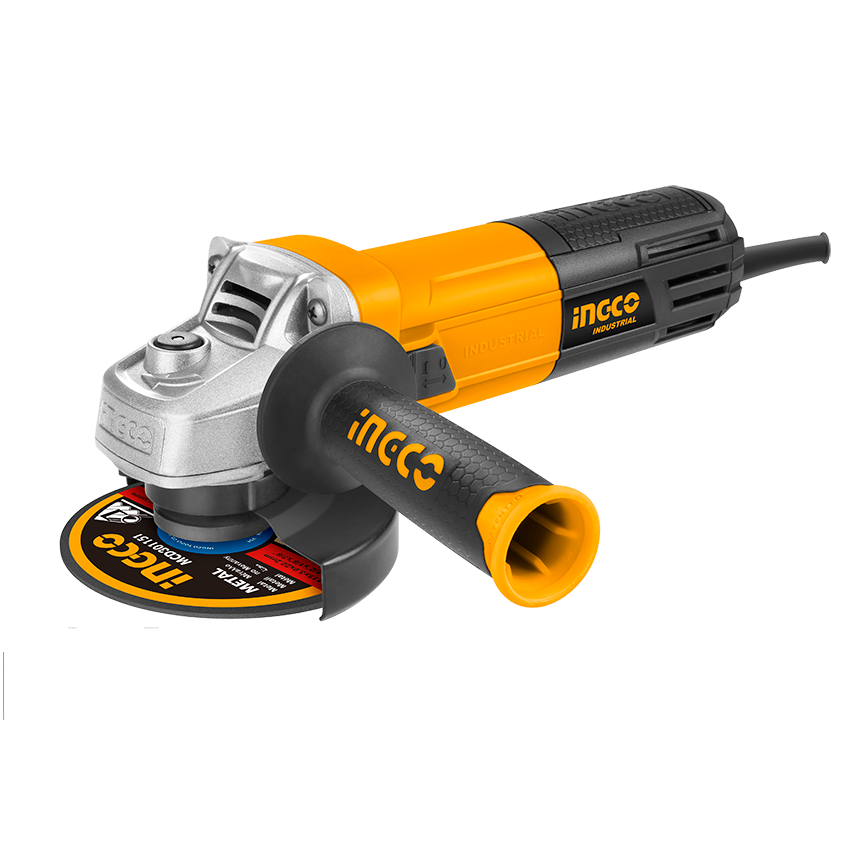Angle Grinder
Angle Grinder

An angle grinder gives you the power and flexibility to cut, grind, and polish materials like metal, tile, or concrete with ease. You’ll find models in both corded and cordless varieties, each offering different perks, from portability to consistent power. Safety is essential—always wear goggles and check attachments before starting. Whether you’re smoothing welds or shaping stone, choosing the right disc makes all the difference. Stick with us and you’ll discover tips, maintenance hacks, and top brand comparisons.
Ingco Angle Grinder 115mm 950W (AG8508)
Key Takeaways
-
Angle grinders are versatile power tools used for cutting, grinding, and polishing metal, masonry, and other materials.
-
They come in corded and cordless models, with various disc types such as abrasive, grinding, and diamond for different tasks.
-
Key safety measures include wearing protective gear, inspecting equipment, and using the guard to prevent injury from sparks and debris.
-
Regular maintenance like cleaning, disc inspection, and proper storage extends tool life and ensures safe operation.
-
Leading brands like DeWalt, Milwaukee, and Bosch offer models with features such as ergonomic handles, quick-change discs, and advanced safety systems.
Key Components and How They Work
At the heart of an angle grinder are several key components that work together to deliver power and precision. You’ll find that the power source—whether electric, battery, or pneumatic—drives the tool.
Once activated, the motor transfers energy to the gear mechanisms. These gears reduce the motor’s speed while increasing torque, allowing you to cut, grind, or polish with control and efficiency.
The spindle, connected to the gears, holds the disc securely in place. You can easily swap out different discs for various tasks. A sturdy guard protects you from sparks and debris, while the handle provides stability during operation.
Each component plays an essential role in ensuring your angle grinder delivers consistent performance and handles demanding jobs with ease.
Common Types and Their Uses
Whether you’re tackling heavy-duty construction or simple home repairs, angle grinders come in several types tailored to specific tasks.
You’ll most often choose between corded and cordless grinder types. Corded grinders offer consistent power, making them ideal for extended, demanding jobs. Cordless grinders give you flexibility and portability, perfect for quick fixes or working in tight spaces.
The type of disc materials you use further expands an angle grinder’s versatility. For cutting metal, opt for abrasive cut-off discs. Grinding discs smooth out welds or remove excess material. Diamond discs work best for cutting through tough materials like concrete or tile. Wire brush wheels help you remove rust or paint from metal surfaces.
Essential Safety Tips for Every User
Before you start any project with an angle grinder, prioritize safety to protect yourself from potential hazards.
Always perform a thorough risk assessment of your workspace, checking for flammable materials, poor lighting, or tripping hazards. Never operate the tool if you’re tired or distracted.
Put on proper protective gear every time—safety goggles, gloves, hearing protection, and a dust mask are essential to shield you from sparks, debris, and loud noise.
Secure loose clothing and tie back long hair to prevent entanglement. Inspect the grinder for damage before use, making sure the guard is in place and secure.
Always maintain a firm grip and clear stance, keeping bystanders away from the work area.
Stick to these fundamentals to work safely and confidently.
Selecting the Right Disc for the Job
Once you’ve covered your safety basics, it’s time to match your angle grinder with the right disc for your task.
Start by considering the material you’re working on—different disc materials are designed for metal, stone, concrete, or wood. For example, cutting discs made of aluminum oxide suit metal, while diamond discs handle masonry.
Next, check disc sizes. Your grinder’s guard and spindle dictate what sizes you can use, so never force a disc that doesn’t fit. Common sizes include 4.5-inch and 7-inch, but always consult your grinder’s manual.
Also, think about the job type—cutting, grinding, or polishing all require specific discs. Choosing properly guarantees efficiency and safety, making your work smoother and protecting your tool and materials.
Step-by-Step Guide to Basic Operation
Getting started with an angle grinder involves a few essential steps to guarantee safe and effective use. First, inspect the tool and disc, ensuring both are in good condition.
Next, put on protective gear—gloves, goggles, and hearing protection are a must. Secure your workpiece, making sure it won’t move during operation. Plug in the grinder or check the battery charge if it’s cordless.
Grip the handle firmly with both hands and position the guard between you and the disc. Before making contact with the material, allow the grinder to reach full speed.
Apply light, steady pressure—don’t force it—using smooth, controlled operating techniques. Always follow recommended safety procedures, such as cutting away from your body and keeping sparks directed safely away from flammable materials.
Maintenance and Care for Longevity
To keep your angle grinder running smoothly and safely, you’ll need to follow a regular maintenance routine. Start by unplugging your tool, then clean dust and debris from vents and moving parts after every use—grinder cleaning prevents build-up that can hinder performance.
Inspect the disc for wear or damage, and replace it if needed. Lubricate bearings according to your manufacturer’s guidelines. Check the power cord and switches for any signs of wear, and address issues promptly to avoid hazards.
Store your angle grinder in a dry, secure place where it won’t be exposed to moisture or accidental impacts—proper tool storage protects both the grinder and its accessories.
Creative Applications Beyond Metalwork
With your angle grinder well-maintained and ready for action, it’s worth exploring its versatility beyond traditional metalwork.
You can use this powerful tool to carve wood, shape stone, or even cut tiles for mosaic designs. Many artists rely on angle grinders for creating intricate artistic sculptures, taking advantage of the grinder’s speed and control for detailed work.
If you’re interested in unconventional projects, experiment with repurposing materials like glass bottles or concrete blocks into functional art pieces.
The angle grinder’s wide range of attachments lets you sand, polish, or engrave surfaces, opening up endless possibilities for creative expression.
Troubleshooting Common Issues
Even the most reliable angle grinder can run into problems from time to time, so it’s important to recognize common issues and know how to address them quickly.
If you notice your grinder overheating, stop using it immediately and let it cool down. Overheating often results from blocked air vents, extended use, or a worn-out motor. Clean the vents and check that you’re not overloading the tool.
Another frequent problem is disc wear. If the disc loses efficiency, appears uneven, or vibrates excessively, replace it right away—using a worn disc is dangerous and reduces performance.
Also, check for unusual noises or reduced power, which might signal internal issues. Regular inspection and timely maintenance help keep your angle grinder running safely and efficiently.
Upgrading and Accessorizing Your Tool
Keeping your angle grinder in top shape doesn’t just depend on maintenance—it’s also about making the most of upgrades and accessories. By exploring accessory options, you’ll expand your grinder’s capabilities far beyond simple cutting or grinding. Attachments like flap discs, wire brushes, and diamond blades let you tackle anything from rust removal to precise tile cutting.
Quick-change systems and upgraded guards can make switching tasks faster and boost safety. Consider tool upgrades such as ergonomic handles or vibration-reducing grips to improve comfort during extended sessions. Dust collection attachments help maintain a cleaner work area and protect your health.
Don’t forget adjustable speed controls if your grinder supports them—they’ll give you finer control for a variety of materials. Investing in the right upgrades keeps your tool versatile and efficient.
Recommended Brands and Models
Although the market offers a wide range of angle grinders, a few brands consistently stand out for their durability, performance, and user-friendly features.
When you're shopping for a reliable tool, consider top brands like Makita, DeWalt, Bosch, and Milwaukee. These manufacturers have established reputations for robust motors and ergonomic designs.
For example, the Makita 9557PBX1 is praised for its balance and power, while the DeWalt DWE402 offers a slim body and quick-change wheel system.
If you prefer cordless options, Milwaukee’s M18 Fuel series delivers impressive battery life and torque. Bosch’s GWS13-50 stands out for its advanced safety features.
Use model comparisons to assess features like motor power, weight, and handle comfort. This approach helps you choose the best angle grinder for your needs.
Frequently Asked Questions
Can Angle Grinders Be Used Underwater or in Wet Conditions?
You shouldn't use most power tools in wet conditions or underwater because you risk electric shock and equipment damage. Always prioritize underwater safety. If necessary, only use tools specifically designed and rated for underwater use.
Are Angle Grinders Suitable for Left-Handed Users?
Did you know that about 10% of people are left-handed? If you're seeking left handed ergonomics and user comfort, look for tools with reversible handles or ambidextrous designs to guarantee you’ll work safely and efficiently.
What Is the Environmental Impact of Frequent Angle Grinder Use?
When you use power tools frequently, you increase air pollution from dust and energy consumption from electricity use. You can reduce your environmental impact by choosing energy-efficient models, using dust extraction systems, and following proper disposal guidelines.
How Noisy Are Angle Grinders During Operation?
You'll feel like you're standing next to a jet engine when you hear these noise levels. Always wear hearing protection, because without it, the relentless roar can seriously harm your ears after just a short session.
Is It Safe to Use an Angle Grinder Near Flammable Materials?
You shouldn't use power tools near flammable materials because fire hazards increase dramatically. Always follow safety precautions—remove any combustible items, wear protective gear, and keep a fire extinguisher close to minimize risks and protect yourself.
Final Remarks
Think of your angle grinder as a trusty steed, ready to charge into any task you set before it. With the right gear, a steady hand, and respect for its power, you’ll conquer challenges from metal mountains to stone valleys. Don’t forget your armor—safety first! As you ride forward, let curiosity lead you to creative horizons. Take care of your steed, and it’ll serve you faithfully through every project’s journey.




